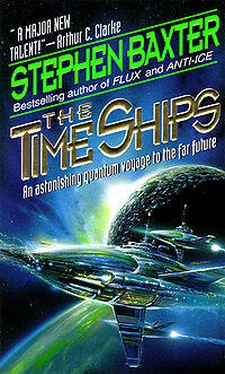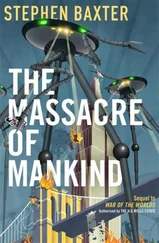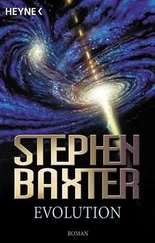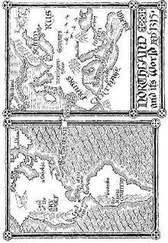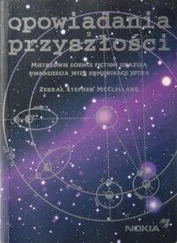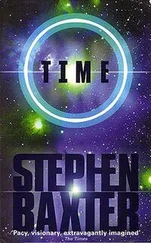There are three Dimensions of Space, through which man may move freely. And time is simply a Fourth Dimension: identical in every important characteristic to the others, except for the fact that our consciousness is compelled to travel along it at a steady pace, like the nib of my pen across this page.
If only — I had speculated, in the course of my studies into the peculiar properties of light — if only one could twist about the four Dimensions of Space and Time — transposing Length with Duration, say — then one could stroll through the corridors of History as easily as taking a cab into the West End!
The Plattnerite embedded in the substance of the Time Machine was the key to its operation; the Plattnerite enabled the machine to rotate, in an uncommon fashion, into a new configuration in the framework of Space and Time. Thus, spectators who watched the departure of the Time Machine — like my Writer — reported seeing the machine spin giddily, before vanishing from History; and thus the driver — myself — invariably suffered dizziness, induced by centrifugal and Coriolis forces which made it feel as if I were being thrown off the machine.
But for all these effects, the spin induced by the Plattnerite was of a different quality from the spinning of a top, or the slow revolution of the earth. The spinning sensations were flatly contradicted, for the driver, by the illusion of sitting quite still in the saddle, as time flickered past the machine — for it was a rotation out of Time and Space themselves.
As night flapped after day, the hazy outline of the laboratory fell away from around me, so that I was delivered into the open air. I was once more passing through that future period in which, I guessed, the laboratory had been demolished. The sun shot like a cannonball across the sky, with many days compressed into a minute, illuminating a faint, skeletal suggestion of scaffolding around me. The scaffolding soon fell away, leaving me on the open hill-side.
My speed through time increased. The flickering of night and day merged into a deep twilight blue, and I was able to see the moon, spinning through its phases like a child’s top. And as I traveled still faster, the cannonball sun merged into an arch of light, spreading across space, an arch which rocked up and down the sky. Around me weather fluttered, with successive flurries of snow white and spring green marking out the seasons. At last, accelerated, I entered a new, tranquil stillness in which only the annual rhythms of the earth itself — the passage of the sun-belt between its solstice extremes — pumped like a heartbeat over the evolving landscape.
I am not sure if I conveyed, in my first report, the silence into which one is suspended when undergoing time travel. The songs of the birds, the distant rattle of traffic over cobbles, the ticks of clocks — even the faint breathing of the fabric of a house itself — all of these things make up a complex, unnoticed tapestry to our lives. But now, plucked from time, I was accompanied only by the sounds of my own breathing and by the soft, bicycle-like creaking of the Time Machine under my weight. I had an extraordinary sensation of isolation — it was as if I had been plunged into some new, stark universe, through the walls of which our own world was visible as if through begrimed window panes — but within this new universe I was the only living thing. A deep sense of confusion descended on me, and worked together with the vertiginous plummeting sensation that accompanies a fall into the future, to induce feelings of deep nausea and depression.
But now the silence was broken: by a deep murmur, sourceless, which seemed to fill my ears; it was a low eddying, like the sound of some immense river. I had noticed this during my first flight; I could not be certain of its cause, but it seemed to me it must be some artifact of my unseemly passage through the stately progress of time.
How wrong I was — as so often in my hasty hypothesis-making!
I studied my four chronometric dials, tapping the face of each with my fingernail to ensure they were working. Already the hand on the second of the dials, which measured thousands of days, had begun to drift away from its rest position.
These dials — faithful, mute servants — were adapted from steam pressure gauges. They worked by measuring a certain shear tension in a quartz bar doped with Plattnerite, a tension induced by the twisting effects of time travel. The dials counted days — not years, or months, or leap years, or movable feasts! — and that was by conscious design.
As soon as I began my investigations into the practicalities of this business of traveling into time, and in particular the need to measure my machine’s position in it, I spent some considerable time trying to build a practical chronometric gauge capable of producing a display in common measures: centuries, years, months and days. I soon found I was likely to spend longer on that project than on the rest of the Time Machine put together!
I developed an immense impatience with the peculiarities of our antique calendar system, which has come from a history of inadequate adjustments: of attempts to fix seed-time and midwinter that go back to the beginnings of organized society.
Our calendar is a historical absurdity, without even the redeeming feature of accuracy at least on the cosmological timescales which I intended to challenge.
I wrote furious letters to The Times, proposing reforms which would enable us to function accurately and without ambiguity on timescales of genuine value to the modern scientist. To begin with, I said, let us discard all this nonsensical clutter of leap years. The year is close to three hundred and sixty-five days and a quarter; and that accidental quarter is the cause of all this ridiculous charade of leap year adjustments. I offered two alternative schemes, both guaranteed to remove this absurdity. We could take the day as our base unit, and devise regular months and years based on multiples of days: imagine a three-hundred-day Year made up of ten Months, each of thirty days. Of course the cycle of seasons would soon drift out of synchronization with the structure of the Year, but — in a civilization as advanced as ours — that would surely cause little trouble. The Royal Observatory at Greenwich, for example, could publish diaries each year to show the dates of the various solar positions the equinoxes and so forth just as, in 1891, all diaries showed the movable feasts of the Christian churches.
On the other hand, if the cycle of seasons is to be regarded as the fundamental unit, then we should devise a New Day as an exact fraction — say a hundredth — of the year. Naturally this would mean that the diurnal round, our periods of dark and light, of sleep and wakefulness, would fall at different times each New Day. But what of that? Already, I argued, many modern cities operated on a twenty-four-hour schedule. And as for the human side of it, simple diary keeping is not a difficult skill to acquire; with the help of proper records one would need plan one’s sleeping and wakefulness no more than a few Days in advance.
Finally I proposed we should look ahead to the day when man’s consciousness is expanded from its nineteenth-century focus on the here-and-now, and consider how things might be when our thinking must span tens of millennia. I envisaged a new Cosmological Calendar, based on the precession of the equinoxes — that is, the slow dipping of the axis of our planet, under the uneven gravitational influence of sun and moon — a cycle which takes twenty millennia to complete. With some such Great Year, we might measure out our destiny in unambiguous and precise terms, now and for all time to come.
Читать дальше
Конец ознакомительного отрывка
Купить книгу
